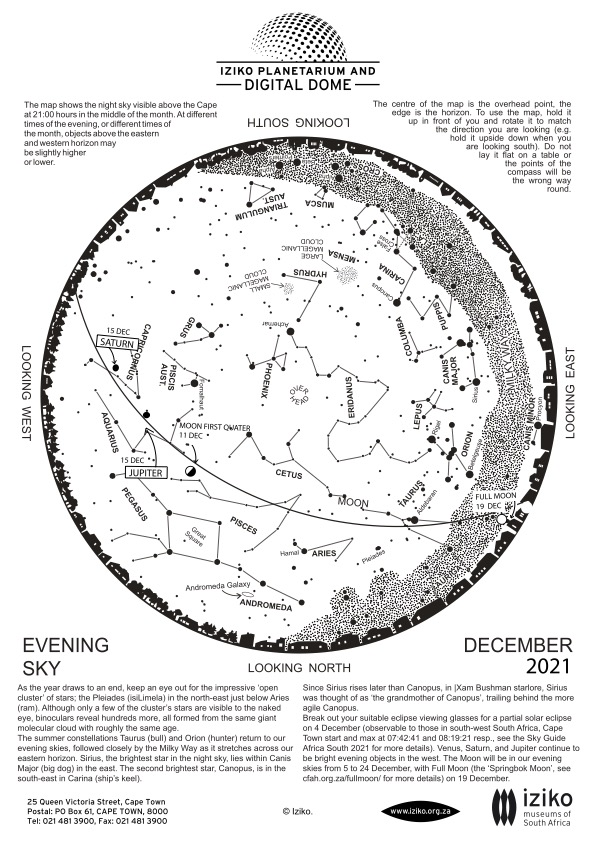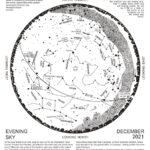
01 Dec Whats Up – December 2021
In a nutshell…
Moon
| Date | Time | Phase |
|---|---|---|
| 04/12 | 09h43 | New Moon |
| 11/12 | 03h35 | First Quarter |
| 19/12 | 06h35 | Full Moon |
| 27/12 | 04h24 | Last Quarter |
Moon – Earth Relations
Perigee: 356 794 km on the 04/12 at 12h03
Apogee: 406 320 km on the 18/12 at 04h14
A partial solar eclipse is visible in South Africa on the 4th of December. In Cape Town, it will commence at 7h42, reach its maximum at 8h19 and end 8h58. Remember that you must always use proper solar viewing or eclipse glasses when looking at the sun. Regular sunglasses are not safe for viewing the sun. See https://www.nasa.gov/content/dec-4-2021-eclipse for more information.
Planet Visibility
Venus is located in Sagittarius and is visible after sunset
Mars is located near Scorpius and visible in the morning sky towards the end of the month
Jupiter is located in Aquarius and is visible in the evening sky
Saturn is located in Capricornus and is visible in the evening sky
Mercury is only visible in the last week of the month near Sagittarius, after sunset
Meteor Showers
Three meteor showers are active in December, the December Phoenicids (active 3rd December – 9th December, peaking on the 6th), the Puppid-Velids (active 5th December – 7th January, peaking on the 29th) and the Geminids. The Geminids are active from the 4th to the 16th of December, peaking early morning on the 14th. Observations of the Geminids, which are one of the strongest meteor showers, can be done from 23:30 p.m. to 3:00 a.m. on the night of the 13th/14th, and the radiant is located towards the Gemini constellation in a NNE direction. Observing prospects for the Puppid-Velids are good and they are best viewed between 22:30 p.m. and 03:30 a.m. looking towards the constellations of Puppis and Vela.
Some easy to identify bright stars
Rigel: blue supergiant in Orion
Betelgeuse: red supergiant in Orion
Procyon: yellowish white star in Canis Minor
Sirius: brightest star in the night sky, located in Canis Major
Antares: red supergiant in Scorpius
Arcturus: red giant in Boötes
Spica: brightest bluish-white star in Virgo
Canopus: yellowish-white star in Carina
Altair: a white star, brightest in Aquila
Regulus: blue–white star and the brightest star in Leo
The Pointers: Alpha and Beta Centauri
Sun and Moon
The New Moon occurs on the 4th of December at 09h43 and the First Quarter Moon falls on the 11th of December at 03h35. The Full Moon occurs on the 19th of December at 06h35 and the Last Quarter Moon falls on the 27th of December at 04h24.
The Moon will be at apogee (furthest from Earth) at a distance of about 406 320 km on the 18th at 04h14. The Moon will be at perigee (closest approach to Earth) at a distance of about 356 794 km on the 4th at 12h03.
There will be a total solar eclipse on the morning of the 4th of December, which will be visible from Antarctica and the Southern Ocean. The eclipse will be seen as a partial one here in Southern Africa. It will not be spectacular, as the fraction of the Sun covered by the Moon will range from 1% to about 11% depending on your location. Cape Town will have about 11,5% coverage. The partial solar eclipse will commence at 7h42, will reach its maximum at 8h19 and will end at 8h58. Remember that you must always use proper solar viewing or eclipse glasses when looking at the sun. Regular sunglasses are not safe for viewing the sun. Please see https://www.nasa.gov/content/dec-4-2021-eclipse for more details.
The Summer Solstice will occur on the 21st of December at 17h53.
Planetary and Other Events – Morning and Evening
The three bright planets Venus, Saturn and Jupiter can still be seen in the western skies just after sunset. Venus is located near the stars of the constellation Sagittarius, dazzles the evening sky brightly and will be near the Moon on 7 December. The beautifully ringed planet Saturn can be located near the stars of the constellation Capricornus, and will be near the Moon on the 8th of December. Jupiter, the biggest planet in our solar system, can be located near the stars of the constellation Aquarius, and is near the Moon on the 9th of December. Mars, the Red Planet, can be seen in the morning sky near the stars of the constellation Scorpius towards the end of the month. Mercury, the smallest planet in our solar system, is trapped in the solar glare and not visible at the beginning of the month. However, it surfaces in the last week of the month in the western skies just after sunset.
Three meteor showers are active in December, the December Phoenicids (active 3rd December – 9th December, peaking on the 6th), the Puppid-Velids (active 5th December – 7th January, peaking on the 29th) and the Geminids. The Geminids are active from the 4th to the 16th of December, peaking early morning on the 14th. Observations of the Geminids, which are one of the strongest meteor showers, can be done from 23:30 p.m. to 3:00 a.m. on the night of the 13th/14th, and the radiant is located towards the Gemini constellation in a NNE direction. Observing prospects for the Puppid-Velids are good and they are best viewed between 22:30 p.m. and 03:30 a.m. looking towards the constellations of Puppis and Vela.
The Evening Sky Stars
The stars of the Great Square of Pegasus and of Andromeda can still be seen low in the north, with the Andromeda Galaxy visible as a faint fuzzy spot below the star Beta Andromedae. It’s believed that in another few billion years, this galaxy will collide with our own Milky Way. Gas and dust clouds will collide, producing large numbers of new stars, but the odds are that not even one star will collide with another. There’s just too much empty space. If the Sun were a 10cm ball, the nearest star system (Alpha Centauri) would be about 3000 km away.
Much of the sky on December evenings is dominated by ‘watery constellations’ and birds. Above Pegasus and Andromeda are the dim stars of the Fishes tied together at their tails with a knot, and above the Fishes is Cetus, the Whale, representing the sea monster coming to devour Andromeda. The most famous star in Cetus is one that’s not usually visible. Named ‘Mira’, i.e. ‘wonderful’, it was first recognised as a periodic variable by the Dutchman Jan Holwarda, who found that this star (discovered in 1596 by Fabricius) reached peak brightness roughly every 11 months, when it would typically be visible as a fairly dim star. In between this mysterious object would disappear. We now know of many similar stars, all of them cool ‘red giants’ hundreds of times the diameter of our own Sun. If Mira were placed at the centre of our solar system, Earth would be inside it!
West of Cetus in the early evening sky is Aquarius (the Water Carrier), while south of Aquarius are the stars of the Southern Fish, headlined by the brightish star Fomalhaut. West of the Southern Fish is the large dim triangle made by the stars of the Sea Goat.
High in the south is the bright star Achernar, with the stars of the Phoenix (the Fire Bird) just above it and the stars of the Toucan and the Crane to the right. The Peacock is moderately low in the SW, below and to the right of the Toucan. Continuing the birds-and-water theme, we find the Water Snake (which looks like a triangle!) directly below Achernar, while the celestial river Eridanus runs its course from Achernar to the knee of Orion, whose stars are rising in the east.
Below Achernar and to the right, among the stars of the Toucan, is the dim glow of the Small Magellanic Cloud. The Large Magellanic Cloud, below Achernar and to the left, is a bit easier to see, and was imagined by some South African groups to be a hunting plain for the gods. The two brightest stars in the sky, Canopus and Sirius, are rising in the southeast and east, respectively, with Orion shouldering his way into the summer skies in the northeast, preceded by Taurus the Bull. The small cluster of stars on the Bull’s shoulder, the Pleiades, were used all over Africa to keep track of the seasons. In isiXhosa, the Pleiades are called isiLimela. Rising in the east as well is the Milky Way, dimmer than the brilliant Milky Way of winter, but still very impressive on a dark Karoo night.
The Morning Sky Stars
The Cross and the Pointers (the two brightest stars in Centaurus) are rising higher in the southeast this month. Just above the Southern Cross and the Housefly are the stars of the great ship Argo as it sails along the Milky Way, accompanied by the dim stars of the Flying Fish. The Milky Way still stretches across the predawn sky from the southeast to the northwest as it did last month, running from Scorpio in the ESE through the Wolf and the Centaur to Argo, then west through the stars of the Unicorn, Orion and the Twins. The southern part is much brighter with obvious dark patches, but all of it will reward a scanner with binoculars, revealing beautiful clumps and clustering of stars. Away from the Milky Way, bright Arcturus glows orange in the NE, with blue-white Spica rising in the E and lonely Alphard, heart of the great Water Serpent, above Regulus high in the north.
If you look carefully at where most of the bright stars are, you’ll notice that they are concentrated near the Milky Way, but offset a bit. These local bright stars are part of a ‘spur’ sticking out at a bit of an angle from the local spiral arm in the great pinwheel of stars that is our Milky Way Galaxy. Ironically, although most of the stars visible in the night sky are brighter than our Sun, most of the stars in the Milky Way Galaxy are much dimmer than the Sun. The common red dwarf stars that make up most of the population are too dim to see unless they are extremely close, while the rare super giants are visible thousands of light years away.
Sivuyile Manxoyi
sivuyile@saao.ac.za
The evening sky over Cape Town
The evening sky over Johannesburg


